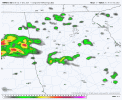HSVweather
Member
Timmer do a live analysis if anyone is interested
One of the reasons why Twitter needs a edit button.Did he mean outside chance? If not I cant find what outside change means lol.
Yeah saw models show some isolated cells later this afternoon. My Alabama football game better not be interrupted ?
Game is on ESPN so no local disruptionsYeah saw models show some isolated cells later this afternoon. My Alabama football game better not be interrupted ?
Unless the storms knock power outGame is on ESPN so no local disruptions
That's good I thought it was espn on ABC for some reasonGame is on ESPN so no local disruptions
Seems like FFC is at least keeping a keen eye on this short window this afternoon for some pretty strong storms16z hrrr simulated radar for 3 oclock todayView attachment 100248
Latest Hrrr certainly shows some storms this afternoon and evening. Will have to see if/how strong they are. Certainly something by to watch.Seems like FFC is at least keeping a keen eye on this short window this afternoon for some pretty strong storms
Area Forecast Discussion
National Weather Service Peachtree City GA
1133 AM EST Fri Dec 31 2021
.UPDATE...
Dense morning fog has largely become more diffuse at this hour,
though a few holdout sites are still reporting visibilities
occasionally a mile or less. Visibilities in these areas will
continue to improve through early afternoon. How the afternoon and
evening forecast plays out is still rather uncertain. The forecast
area remains situated in the weakly forced warm sector. We have
already seen some isolated showers and a thunderstorm or two
across portions of north Georgia this morning. If additional
convection is able to develop and sustain itself this afternoon
and evening, the environment would be capable of supporting an
isolated severe threat. A couple of recent CAM runs have supported
the idea of a couple of isolated cells of supercellular appearance in
north Georgia by late afternoon and early evening, so this
potential will be monitored. Otherwise, it will remain another
very warm day with record breaking highs again possible.

Hmmm. No mention of Georgia but they have Georgia circled ?Latest SPC mesoscale discussion on Alabama severe potential this afternoon. Still seems rather conditional and they mention the hrrr as an outlier. Will have to monitor trends.View attachment 100276
Looks like another night time event for our area.Interesting
View attachment 100298
Needs a tornado warning. It's pretty tight nowView attachment 100329
NE Alabama mischief
That's dangerous. Mobile home being flipped over. Hope nobody was hurt
That's dangerous. Mobile home being flipped over. Hope nobody was hurt
TDS tornado on the ground with this one!Tornado warningView attachment 100386
